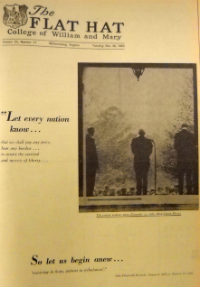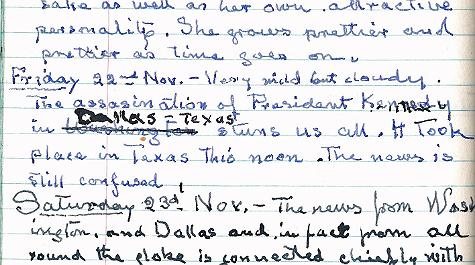SCRC catalogs community response to JFK assassination
Fifty years have passed since the assassination of President John F. Kennedy on Nov. 22, 1963. Just as most students, faculty and staff at William & Mary can tell you exactly what they were doing when they first learned about the Sept. 11 attacks, the news of Kennedy’s assassination likewise left an indelible mark on those hearing it.
Many people, students and members of the Williamsburg community alike, put their thoughts onto paper in the days following the assassination. The staff at Swem Library’s Special Collections Research Center has collected several of these firsthand accounts in commemoration of the 50th anniversary, making them available to all who wish to pause and remember.
In the ’60s, the Flat Hat was published weekly on Fridays. On Nov. 26, 1963 — a Tuesday — a special edition came out. Dominating the front page is a large picture of a campus community solemnly gathering to receive the news. Alongside it is a quote from Kennedy’s inaugural address: “Let every nation know…that we shall pay any price, bear any burden…to assure the survival and success of liberty…So let us begin anew…‘rejoicing in hope, patient in tribulation.’”
Dominating the front page is a large picture of a campus community solemnly gathering to receive the news. Alongside it is a quote from Kennedy’s inaugural address: “Let every nation know…that we shall pay any price, bear any burden…to assure the survival and success of liberty…So let us begin anew…‘rejoicing in hope, patient in tribulation.’”
Lloyd Stableford ’64 was a member of the crowd preserved in the Nov. 26 Flat Hat. During the confused, fateful hours following the shooting, Stableford returned to his dorm and, sitting at his Royal typewriter, began to process his thoughts. He shared what he wrote with the AARP blog.
“It is now thirty hours since the fatal shooting of the President of the United States, John Fitzgerald Kennedy. Here, at the College of William and Mary, all is relatively quiet. The sky is still overcast, after a midafternoon drizzle, and the air is turning cool,” he wrote.
The weather may have been typical for William & Mary in November, but the atmosphere was anything but.
“The professor walked in with a stare in his eyes that I cannot forget,” Stableford wrote.
The radio announcer, on whose every word the gathered class hung, paused. Then came the news that the president had died.
“I said softly, in disbelief, ‘No!’” Stableford wrote. “The classroom slowly emptied, students, stunned and teary-eyed.”
Beyond William & Mary’s walls, people in communities around the nation also struggled to process their thoughts. Special Collections has acquired the personal dairies of five women living around the East Coast when the assassination occurred, each containing a poignant blend of daily musings alongside reactions to the tragedy.
Mary Haldane Begg Coleman (1875-1967), a longtime resident of Yorktown and Williamsburg, was around 85 years old and lived in the Tucker House in Williamsburg when news of the President’s death spread. Coleman had lived through three presidential assassinations (Garfield, McKinley, and Kennedy) as well as two attempts (T. Roosevelt and F. Roosevelt).
Her diary entry for Nov. 22, 1963 states: “Very mild but cloudy. The assassination of President Kennedy in Dallas, Texas stuns us all. It took place in Texas this noon. The news is all confused.”
Daily life in Williamsburg found an uneasy balance with the assassination’s fallout in her Nov. 24 entry.
“Much colder, but a lovely day. Things continue violent in Dallas. The man suspected of killing the President, has now been killed by someone! Our day was active. Mrs. Bolton came to lunch. Then the Barlowes were here in the afternoon,” she wrote.
The extensive diary collection of another longtime Peninsula resident, Elanor Wormley Perrin (1883-1975) of Gloucester, records nearly a half-century of daily life in 20th century Virginia. Her entry on the day of the assassination shows the tragedy’s shocking intrusion into her otherwise tranquil existence.
“Clear & mild. To C. H. in A. M. Eliz telephoned they were at Gloucester Point. While at lunch we heard over T. V. that President Kennedy had been shot. A little later heard he had died, awful. Texas governor also shot, but not as severely wounded. An awful thing. Listened rest of day to T. V.,” she wrote on Nov. 22.
The Special Collections diary archives go beyond that grey November weekend—Coleman and Perrin both kept detailed journals for decades. Special Collections also has the collected diaries of Hester Barrows of Fulton, New York; Violet L. Barnett of West Chester, Pennsylvania; and Eva L. Webb of Corry, Pennsylvania. Each woman’s diaries cover not only the weekend of the assassination, but also provide a glimpse into decades of their day-to-day lives.
Special Collections has produced a blog post detailing these dairies in commemoration of the assassination’s 50th anniversary, and the diaries themselves can be viewed in person at Swem’s Special Collections Research Center. The entire Flat Hat archive is available on William & Mary’s digital archive.
 Skip to main content
Skip to main content

